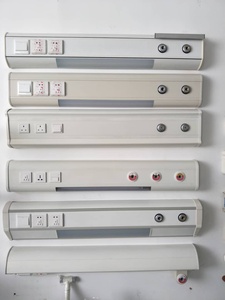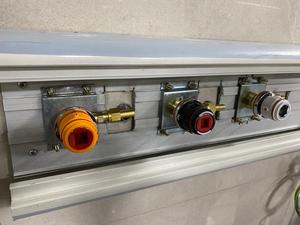(51 products available)


































































































































































































































ICU beds motorized are advanced hospital beds designed for patients in critical care. They come in different types, including:
Full electric ICU beds
These are the most common types of motorized ICU beds. They have electric-powered adjustments that raise or lower the head, foot, and height of the bed. The controls are handheld, enabling nurses to make changes quickly. Patients can also control the bed from the bedside panel. These beds enhance patient comfort and make it easy for them to get in and out of bed. The beds also allow for the trendelenburg position, improving blood circulation.
Semi-electric ICU beds
These ICU beds have electric-powered head, foot, and manual height adjustments. They are less expensive than full-electric beds and are mostly used in less critical care units. The beds come with a mechanical crank in case of power failure. They offer comfort to patients and are ideal for long-term care facilities.
Manual ICU beds
These are the most basic ICU beds. They have completely adjustable beds but rely on manual cranks for all adjustments. They require nurses to use hand gears to change the position of the bed, making them less convenient. Manual ICU beds are mostly used when there is no electricity. They are also used in rural hospitals that have a low budget.
Traction ICU beds
The traction ICU beds are designed to manage patients with spinal injuries. They have a cervical traction system that helps stabilize the spine and relieve pain. The beds have adjustable pulleys and weights that align the spine. They are mostly used in orthopedic intensive care units.
Bariatric ICU beds
Bariatric ICU beds are designed for overweight patients. They have a wider and more robust frame to accommodate patients weighing over 350 pounds. These beds have reinforced structures to ensure durability. They also come with advanced weight capacity. The beds have electric adjustments, including variable height adjustments and backrest adjustments.
Smart ICU beds
Smart ICU beds are the latest technology in critical care. They come with advanced features and intelligent automation. The beds have pressure sensors that monitor the patient's position and automatically adjust to prevent bedsores. They have integrated diagnostic tools that monitor vitals like heart rate, blood pressure, and oxygen levels. Smart ICU beds are expensive and mostly used in highly advanced hospitals.
When buying ICU motorized beds for sale, it is important to understand their features and functions. The features and functions are what determine the needs of the patients in critical care. Here are some of the functions of motorized ICU beds.
Adjustable Head and Foot Sections
Motorized ICU beds have adjustable head and foot sections. This allows the backrest and footrest to be adjusted to different positions. These positions can be straight, inclined or lifted. This helps in positioning the patients comfortably. It also ensures ease when attending to them. Adjusting the head and foot sections improves blood circulation to the patients. This reduces pressure on the back and improves the patient's comfortability. The adjustments are made using a remote control or a handset.
Height Adjustment
Height adjustment is an important feature of ICU motorized beds. The height adjustment is made possible by the bed's hydraulic lift system. This allows the bed to be raised or lowered. Raising the ICU beds makes it easier for the patients to get out and move around. Lowering the bed makes it easier for the patients to get on. Height adjustment allows caregivers to raise the bed to a comfortable level for easy attending. This reduces back strain for the caregivers.
Trendelenburg and Reverse Trendelenburg Positions
Some motorized ICU beds allow the patients to be positioned in a trendelenburg or reverse trendelenburg position. The trendelenburg position is where the head is lowered and the feet are raised. The reverse trendelenburg position is where the head is elevated and the feet are lowered. These positions help in stabilizing critically ill patients. They assist in treating patients with respiratory distress. Trendelenburg position helps in improving blood flow to vital organs. This is important for patients with hypotension.
Side Rails
These are also known as hospital bed rails. They are an important feature of motorized ICU beds. The side rails provide safety and security for the patients. They prevent the patients from accidentally falling off the bed. This is important for patients who are weak or disoriented. The side rails also give the patients a sense of security. They help in building their confidence. Most ICU beds have electric side rails. The electric side rails can be raised or lowered with the push of a button.
Motorized ICU beds are used in different scenarios. Here are some of them:
Intensive Care Units
Motorized ICU beds are mainly used in ICUs. These are specialized hospital wards. The wards cater to patients who require constant monitoring. The beds allow medical personnel to adjust their positions. They can lift the head, raise the legs or incline the whole bed. This helps in managing critically ill patients. The adjustments help in improving patient comfort. Also, they aid in reducing pressure ulcers.
Post-operative Care
These beds are also used in post-operative care. After surgery, patients are placed in these motorized beds. The reason for this is that they can be adjusted with the remote. This helps in easing any form of discomfort or pain. Besides, the beds have built-in recliners. They can help in elevating the upper body or legs. This minimizes the risk of blood clots forming in the patients.
Trauma Units
Motorized ICU beds are common in trauma units. These are hospital departments that deal with severe injuries. Patients admitted in trauma units require constant monitoring. Motorized ICU beds assist in tracking their vital signs. This is because the beds can be integrated with monitoring devices. Also, the adjustable positions help in providing comfort to the patients. This may lead to a decrease in stress and pain.
Neonatal Intensive Care Units (NICUs)
Motorized ICU beds are also referred to as incubators. These beds offer a controlled environment for premature infants. The adjustable functions of the beds help in positioning delicate babies. This ensures proper development of their growing organs. The beds also incorporate phototherapy units. These units aid in treating jaundiced newborns.
Hospice and Palliative Care
Motorized ICU beds are used in hospice care. They help patients with terminal illnesses. These patients require specialized care that focuses on comfort. Motorized ICU beds enhance patient comfort. They enable patients to find the right position that suits them. These beds also help in relieving pain. They allow caregivers to assist patients in executing simple tasks like lifting their legs.
When purchasing an electric hospital bed for sale, consider the following factors;
Safety features
Look for motorized ICU beds equipped with safety features such as bed rails, emergency stop buttons, and anti-collision sensors. The side rails should be adjustable and lockable to prevent patients from falling off the bed. Anti-collision sensors will detect obstacles when the bed is being moved to prevent injuries.
Adjustability and patient comfort
When purchasing motorized ICU beds, prioritize beds with multiple adjustable positions. The bed should have adjustable head and foot sections and height adjustments. Such beds provide patients with optimum comfort. Additionally, consider beds with memory foam mattresses and ergonomic designs.
Easy to use
Choose motorized ICU beds that are simple to operate. The hand controls should have clear labels and easy-to-reach buttons. Consider beds with preset functions for common positions. Additionally, look for beds with locking wheels for easy mobility and stability.
Durability and build quality
Ensure the motorized ICU beds are made of durable materials. The materials should be long-lasting and withstand frequent adjustments. Consider beds with reinforced frames and high-quality motors. Additionally, choose beds with high weight capacities.
Maintenance and cleaning
Motorized ICU beds require regular maintenance and cleaning to ensure optimum functionality and hygiene. Therefore, consider beds that are easy to maintain and clean. Choose beds with detachable and washable components. Additionally, consider beds with waterproof and anti-bacterial surfaces.
Compatibility with medical equipment
Motorized ICU beds should be compatible with various medical equipment. Therefore, consider beds that are compatible with oxygen concentrators, IV stands, and bedside cabinets. Additionally, ensure the ICU beds have sufficient space for medical accessories.
Consultation with healthcare professionals
Before purchasing motorized ICU beds consult with healthcare professionals. They will provide insights on the essential features and specifications of the ICU beds. Additionally, they will recommend the best brands and models that suit the healthcare facility needs.
Q1: What materials are used in the construction of motorized ICU beds?
A1: Motorized ICU beds are made of strong, durable materials. The frame is usually made of steel or heavy-duty aluminum. These materials don't bend or break easily. The surface that supports the mattress is typically made of reinforced plastic or metal slats. This allows air circulation beneath the mattress. The head and foot sections may use molded plastic or metal for stability and easy cleaning. Overall, motorized ICU beds are constructed with long-lasting, sturdy materials to ensure patient safety and comfort.
Q2: What is the weight capacity of a motorized ICU bed?
A2: The weight capacity varies depending on the model and manufacturer. Most standard motorized ICU beds can safely support patients weighing up to 450 pounds. Some heavy-duty models have a weight capacity of up to 1,000 pounds. It's important for healthcare facilities to check the specifications and choose a bed that can accommodate their patients' weights comfortably.
Q3: What is the average lifespan of an motorized ICU bed?
A3: With proper care and maintenance, the average lifespan of a motorized ICU bed is between 10 to 15 years. Factors that can affect its longevity include the quality of construction, frequency of use, and how well it is maintained. Performing regular inspections, cleaning, and replacing worn-out parts can help extend the lifespan of the bed.
Q4: Are motorized ICU beds difficult to assemble?
A4: Motorized ICU beds are not difficult to assemble. They come with pre-assembled parts that need to be connected. The manufacturer usually provides a manual guide with simple instructions on how to safely and correctly assemble the bed. Healthcare facilities can also have trained technicians perform the assembly.
Q5: Can a motorized ICU bed be used in home care settings?
A5: Yes, a motorized ICU bed can be used in homecare settings. It has multiple adjustable positions that enhance comfort and relieve pain from chronic illnesses. The adjustable head, knee, and flat positions help bedridden patients stay comfortable. It also helps prevent bedsores by allowing caregivers to change patients' positions.